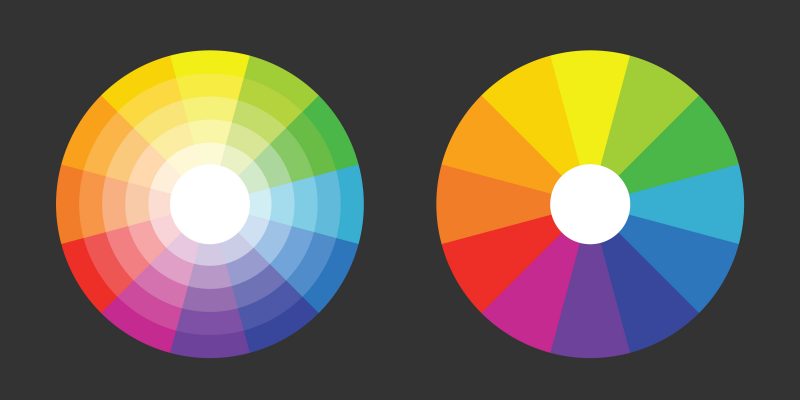We explain what the color wheel is and how its colors are represented. Also, the natural color wheel and its models.

What is the color wheel?
It is known as color wheel or color wheel to the graphic, ordered and circular representation of the colors visible to the human eye according to their hue or tone, often distinguishing between primary colors and their derivatives. It is used both in subtractive representations of color (artistic or pictorial) and in additive (luminous) representations.
Commonly, color wheels are represented in a gradient of colors that make the transition from one tonality to another visible. Other shapes include the stepped pattern, which includes 6, 12, 24, 48 or more different colors, and the hexagram, in the shape of a star, whose peaks represent each color, allowing opposites and complements to be easily visualized.
These chromatic tools are longstanding in human history. Already in 1436 the Renaissance artist and thinker Leonardo Battista Alberti, in his treatise From picturecreated various geometric representations for the range of colors, including the circle, the rectangle and the triangle, from the four primary colors considered at the time: yellow, green, blue and red.
On the other hand, the model that inspires the current one, composed of the three primary colors (yellow, blue and red) and their respective derivations, It was invented in the 17th century and is known as RYB (for the acronym in English of its primary colors: Grid, Yellow, Blue). It was popularized in a book by the German poet Goethe called color theory (1810), in which he reached six colors in total and which is still taught in painting academies.
This traditional model of the color wheel states that:
- The warm colors of the spectrum are located to the right of the circle, and the cold colors, therefore, to the left.
- Colors have an opposite on the wheel: blue is opposite orange, red is opposite green, yellow is opposite violet, and so on.
See also: Plastic arts
The natural color wheel
When all the colors of the visible spectrum of light are distributed on a color wheel, we have a natural color wheel. This arises from Newton's studies of the nature of light and the subsequent emergence of color photography, thus being a fundamental tool in the color industry.
In this way, new models of color organization emerged, such as RGB (red, green, blue; in Spanish: red, green, blue), which operates based on the intensity of these three primary colors of light; or CMYK (cYanmagentandellow, black; in Spanish: cyan, magenta, yellow and black), modern version of the one proposed by Goethe and widely used in publishing and industrial printing.
These contemporary models can be classified into two:
- Additive color models They propose the composition of a color from the incorporation of light, that is, from the sum of colors, moving towards white. According to this model, the opposite colors are: yellow – blue, magenta – green, cyan – red.
- Subtractive color models They propose the composition of color from the subtraction of light, that is, moving towards black in the superposition of colors. According to this model, the opposite colors are: red – cyan, green – magenta, blue – yellow.
Black and white are opposite colors, although they are not really colors but tones, just like gray: they do not present color. White is considered the meeting of all the colors of the spectrum (with a large dose of light and energy) while black, on the other hand, is considered the absence of all colors (and therefore with very little light and energy).





